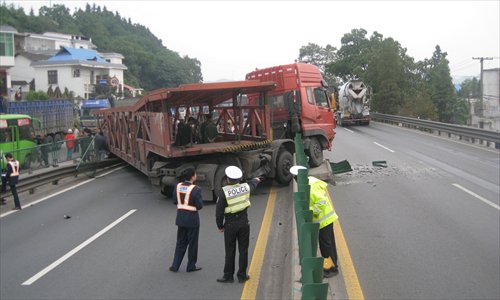HOME >> CHINA
Four-wheeled danger
Source:Xinhua-Global Times Published: 2015-4-9 21:43:01
Lack of legislation keeps drug-impaired drivers on the road

Police officers in Jiujiang, Jiangxi Province, investigate a crash site, which was caused by a driver under the influence of drugs. Photo: CFP
A driver under the influence of drugs in Changshou district, Chongqing began to dance to the flashing police light in the presence of police officers, bobbing his head and shaking his body.
He had mistaken the police light for disco ball light when police stopped and checked his car on the night of March 30, the Chongqing Economic Times reported. He was arrested on suspicion of driving under the influence of drugs and driving without a license.
However, as driving under the influence of drugs has yet to be incorporated into China's Criminal Law, a drug-impaired driver will only receive an administrative penalty if the driving causes no casualties, while they can be charged with "crimes causing traffic casualties" when traffic accidents take place.
With more traffic accidents resulting from driving on drugs, more legal experts, traffic police and drug control officials have called for the activity to be criminalized. Experts say [lawmakers] should not stop pushing legislation, although, at present, methods for testing for the presence of drugs on the scene may not be up to snuff.
More threats
By the end of 2014, China had 2.95 million registered drug addicts, according to a drug control report released by China's National Narcotics Control Commission on March 25.
Fang Kezhu, a drug control professor at Yunnan Police Officer Academy in Southwest China, said that 20 percent of unregistered drug abusers hold driving licenses.
He added that driving under the influence of drugs is more likely to cause multiple-vehicle collisions, and mass injuries or deaths.
On March 21, a man driving an off-road vehicle under the influence in Wuhan, Hubei Province, collided head-on with three cars and an electric bike, killing one person and injuring another. Another man in Nanjing, Jiangsu Province ran his car into a bus stop, causing one death and three injuries.
If the addict is a bus driver, the results can be even more horrific. Wang Zhenwei, a tour bus driver in Changshu, Jiangsu Province caused 14 deaths on the highway in 2012 after taking methamphetamines to stay awake following two straight days of no sleep, news portal jschina.com.cn reported. He received a maximum of seven years behind bars on the charge of causing traffic casualties.
A drug-impaired driver in Kunming, Yunnan Province was caught driving a bus with over 30 passengers on board in 2013, after taking heroin earlier the same morning. Although his driving license was revoked and he was forced to undergo three years of addiction treatment, he was still able to obtain another license afterwards.
Barriers to legislation
Yao Fei, an anti-drug policeman in Kunming, said that the seemingly higher frequency of drunk driving accidents is because of legislation and increased attention from the police.
However, driving under the influence of drugs poses a greater threat than drunk driving, Yao said.
Fang agreed, citing a British study. The study, conducted by the Transport Research Laboratory for the British Royal Automobile Club Foundation, showed that the reaction time of people high on marijuana was slowed by 21 percent, whereas those who were drunk slowed by 12 percent, media outlet dailytech.com reported in 2008.
"People who take drugs, especially new types of drugs, are mentally unstable and usually subject to hallucinations. They may feel they're being chased, for example," Yao explained.
But unlike simple breath tests that can be used to confirm drunk driving, it is hard to detect whether drivers are under the influence of drugs, unless they are driving in an extremely abnormal fashion. A lack of practical testing methods has delayed the introduction of legislation.
Drugs are chemically complicated substances. Taking anti-inflammatory medicines and cold remedies can produce the same positive results as narcotics.
Drugs can be detected in the bloodstream after several days, highlighting the need to define what length of time after drug usage can reasonably be considered "driving under the influence."
In addition, new types of drugs emerge constantly, making it difficult for testing technology to keep up, although tests for major drugs, such as methamphetamines, ephedrine and ketamine, are now based on mature technology.
Random drug testing typically uses saliva samples to test for the active ingredient in cannabis, as well as speed and ice, both of which contain methamphetamines, according to the official website of Australian police.
Lang Yu, another professor at Yunnan Police Officer Academy, suggested that the Chinese police resort to saliva samples as a preliminary screening test. If the result is positive, blood testing can be used for confirmation, he said.
"Testing methods cannot keep up with the development of new drugs at present. But if we wait until [testing technology] is mature to make driving under the influence of drugs a crime, it will be too late," Lang pointed out.
Traffic police in Shenyang, Liaoning Province introduced drug testing strips for the first time in January, with accuracy rates reaching 99 percent, the Xinhua News Agency reported.
Fang said China should model its approach on other countries, explaining that, like drunk driving, China can legislate driving under the influence of drugs by punishing offenders under the crime of dangerous driving.
The British government introduced new regulations on drivers in March. If they are caught behind the wheel with certain levels of designated illegal and prescription drugs in their bloodstream, including heroin, cocaine or cannabis, they will be prosecuted, the London Evening Standard reported.
Penalties include a one-year driving ban, a £5,000 ($7,461) fine or up to 12 months in prison, The Guardian reported on March 2.
Posted in: Society